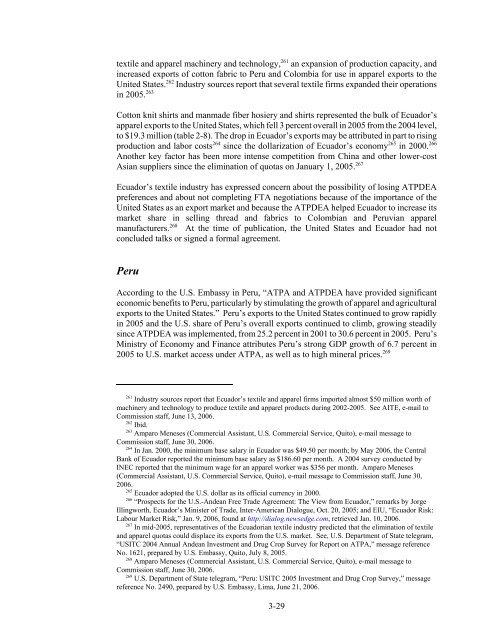The Impact of the Andean Trade Preference Act Twelfth ... - USITC
The Impact of the Andean Trade Preference Act Twelfth ... - USITC
The Impact of the Andean Trade Preference Act Twelfth ... - USITC
- No tags were found...
Create successful ePaper yourself
Turn your PDF publications into a flip-book with our unique Google optimized e-Paper software.
textile and apparel machinery and technology, 261 an expansion <strong>of</strong> production capacity, andincreased exports <strong>of</strong> cotton fabric to Peru and Colombia for use in apparel exports to <strong>the</strong>United States. 262 Industry sources report that several textile firms expanded <strong>the</strong>ir operationsin 2005. 263Cotton knit shirts and manmade fiber hosiery and shirts represented <strong>the</strong> bulk <strong>of</strong> Ecuador’sapparel exports to <strong>the</strong> United States, which fell 3 percent overall in 2005 from <strong>the</strong> 2004 level,to $19.3 million (table 2-8). <strong>The</strong> drop in Ecuador’s exports may be attributed in part to risingproduction and labor costs 264 since <strong>the</strong> dollarization <strong>of</strong> Ecuador’s economy 265 in 2000. 266Ano<strong>the</strong>r key factor has been more intense competition from China and o<strong>the</strong>r lower-costAsian suppliers since <strong>the</strong> elimination <strong>of</strong> quotas on January 1, 2005. 267Ecuador’s textile industry has expressed concern about <strong>the</strong> possibility <strong>of</strong> losing ATPDEApreferences and about not completing FTA negotiations because <strong>of</strong> <strong>the</strong> importance <strong>of</strong> <strong>the</strong>United States as an export market and because <strong>the</strong> ATPDEA helped Ecuador to increase itsmarket share in selling thread and fabrics to Colombian and Peruvian apparelmanufacturers. 268 At <strong>the</strong> time <strong>of</strong> publication, <strong>the</strong> United States and Ecuador had notconcluded talks or signed a formal agreement.PeruAccording to <strong>the</strong> U.S. Embassy in Peru, “ATPA and ATPDEA have provided significanteconomic benefits to Peru, particularly by stimulating <strong>the</strong> growth <strong>of</strong> apparel and agriculturalexports to <strong>the</strong> United States.” Peru’s exports to <strong>the</strong> United States continued to grow rapidlyin 2005 and <strong>the</strong> U.S. share <strong>of</strong> Peru’s overall exports continued to climb, growing steadilysince ATPDEA was implemented, from 25.2 percent in 2001 to 30.6 percent in 2005. Peru’sMinistry <strong>of</strong> Economy and Finance attributes Peru’s strong GDP growth <strong>of</strong> 6.7 percent in2005 to U.S. market access under ATPA, as well as to high mineral prices. 269261Industry sources report that Ecuador’s textile and apparel firms imported almost $50 million worth <strong>of</strong>machinery and technology to produce textile and apparel products during 2002-2005. See AITE, e-mail toCommission staff, June 13, 2006.262 Ibid.263Amparo Meneses (Commercial Assistant, U.S. Commercial Service, Quito), e-mail message toCommission staff, June 30, 2006.264In Jan. 2000, <strong>the</strong> minimum base salary in Ecuador was $49.50 per month; by May 2006, <strong>the</strong> CentralBank <strong>of</strong> Ecuador reported <strong>the</strong> minimum base salary as $186.60 per month. A 2004 survey conducted byINEC reported that <strong>the</strong> minimum wage for an apparel worker was $356 per month. Amparo Meneses(Commercial Assistant, U.S. Commercial Service, Quito), e-mail message to Commission staff, June 30,2006.265Ecuador adopted <strong>the</strong> U.S. dollar as its <strong>of</strong>ficial currency in 2000.266“Prospects for <strong>the</strong> U.S.-<strong>Andean</strong> Free <strong>Trade</strong> Agreement: <strong>The</strong> View from Ecuador,” remarks by JorgeIllingworth, Ecuador’s Minister <strong>of</strong> <strong>Trade</strong>, Inter-American Dialogue, Oct. 20, 2005; and EIU, “Ecuador Risk:Labour Market Risk,” Jan. 9, 2006, found at http://dialog.newsedge.com, retrieved Jan. 10, 2006.267 In mid-2005, representatives <strong>of</strong> <strong>the</strong> Ecuadorian textile industry predicted that <strong>the</strong> elimination <strong>of</strong> textileand apparel quotas could displace its exports from <strong>the</strong> U.S. market. See, U.S. Department <strong>of</strong> State telegram,“<strong>USITC</strong> 2004 Annual <strong>Andean</strong> Investment and Drug Crop Survey for Report on ATPA,” message referenceNo. 1621, prepared by U.S. Embassy, Quito, July 8, 2005.268Amparo Meneses (Commercial Assistant, U.S. Commercial Service, Quito), e-mail message toCommission staff, June 30, 2006.269U.S. Department <strong>of</strong> State telegram, “Peru: <strong>USITC</strong> 2005 Investment and Drug Crop Survey,” messagereference No. 2490, prepared by U.S. Embassy, Lima, June 21, 2006.3-29
















